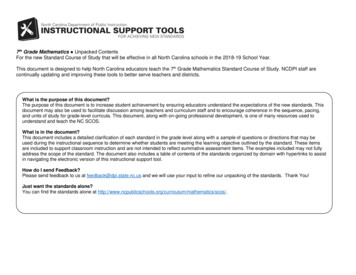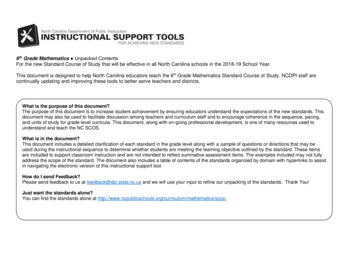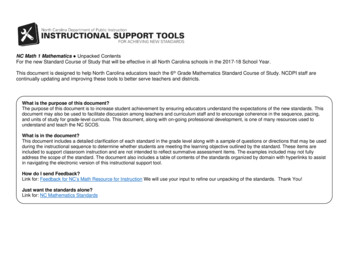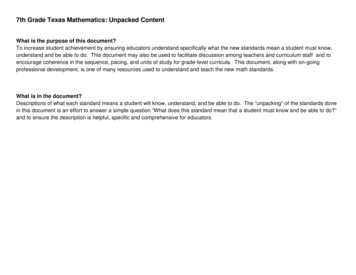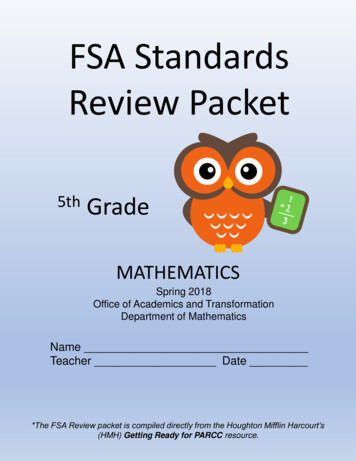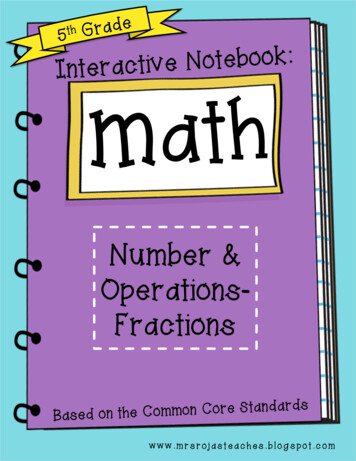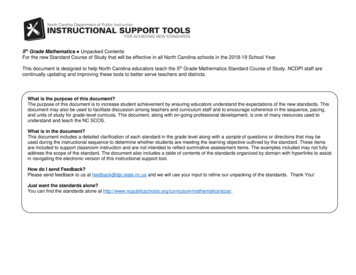
Transcription
5th Grade Mathematics Unpacked ContentsFor the new Standard Course of Study that will be effective in all North Carolina schools in the 2018-19 School Year.This document is designed to help North Carolina educators teach the 5th Grade Mathematics Standard Course of Study. NCDPI staff arecontinually updating and improving these tools to better serve teachers and districts.What is the purpose of this document?The purpose of this document is to increase student achievement by ensuring educators understand the expectations of the new standards. Thisdocument may also be used to facilitate discussion among teachers and curriculum staff and to encourage coherence in the sequence, pacing,and units of study for grade-level curricula. This document, along with on-going professional development, is one of many resources used tounderstand and teach the NC SCOS.What is in the document?This document includes a detailed clarification of each standard in the grade level along with a sample of questions or directions that may beused during the instructional sequence to determine whether students are meeting the learning objective outlined by the standard. These itemsare included to support classroom instruction and are not intended to reflect summative assessment items. The examples included may not fullyaddress the scope of the standard. The document also includes a table of contents of the standards organized by domain with hyperlinks to assistin navigating the electronic version of this instructional support tool.How do I send Feedback?Please send feedback to us at feedback@dpi.state.nc.us and we will use your input to refine our unpacking of the standards. Thank You!Just want the standards alone?You can find the standards alone at ics/scos/.
North Carolina Course of Study – 5th Grade StandardsStandards for Mathematical PracticeOperations & AlgebraicThinkingWrite and interpret numericalexpressions.NC.5.OA.2Analyze patters andrelationships.NC.5.OA.3Number & Operations inBase TenUnderstand the place valuesystem.NC.5.NBT.1NC.5.NBT.3Perform operations withmulti-digit whole numbers.NC.5.NBT.5NC.5.NBT.6Perform operations withdecimals.NC.5.NBT.7North Carolina Department of Public InstructionNumber & OperationsFractionsUse equivalent fractions as astrategy to add and subtractfractions.NC.5.NF.1Apply and extend previousunderstandings ofmultiplication and division tomultiply and divide fractions.NC.5.NF.3NC.5.NF.4NC.5.NF.72Measurement & DataConvert like measurementunits within a givenmeasurement system.NC.5.MD.1Represent and interpretdata.NC.5.MD.2Understand concepts ofvolume.NC.5.MD.4NC.5.MD.5GeometryUnderstand the coordinateplane.NC.5.G.1Classify quadrilaterals.NC.5.G.35th Grade Unpacking Document Rev. June 2018
Standards for Mathematical PracticePracticeExplanation and Example1. Make sense of problemsand persevere in solvingthem.Mathematically proficient students in grade 5 should solve problems by applying their understanding of operations with wholenumbers, decimals, and fractions including mixed numbers. They solve problems related to volume and measurementconversions. Students seek the meaning of a problem and look for efficient ways to represent and solve it. They may checktheir thinking by asking themselves, “What is the most efficient way to solve the problem?”, “Does this make sense?”, and“Can I solve the problem in a different way?”.Mathematically proficient students in grade 5 should recognize that a number represents a specific quantity. They connect quantitiesto written symbols and create a logical representation of the problem at hand, considering both the appropriate units involved and themeaning of quantities. They extend this understanding from whole numbers to their work with fractions and decimals. Students writesimple expressions that record calculations with numbers and represent or round numbers using place value concepts.In fifth grade mathematical proficient students may construct arguments using concrete referents, such as objects, pictures,and drawings. They explain calculations based upon models and properties of operations and rules that generate patterns.They demonstrate and explain the relationship between volume and multiplication. They refine their mathematicalcommunication skills as they participate in mathematical discussions involving questions like “How did you get that?” and“Why is that true?” They explain their thinking to others and respond to others’ thinking.Mathematically proficient students in grade 5 experiment with representing problem situations in multiple ways including numbers,words (mathematical language), drawing pictures, using objects, making a chart, list, or graph, creating equations, etc. Studentsneed opportunities to connect the different representations and explain the connections. They should be able to use all of theserepresentations as needed. Fifth graders should evaluate their results in the context of the situation and whether the results makesense. They also evaluate the utility of models to determine which models are most useful and efficient to solve problems.Mathematically proficient fifth graders consider the available tools (including estimation) when solving a mathematical problemand decide when certain tools might be helpful. For instance, they may use unit cubes to fill a rectangular prism and then usea ruler to measure the dimensions. They use graph paper to accurately create graphs and solve problems or makepredictions from real world data.Mathematically proficient students in grade 5 continue to refine their mathematical communication skills by using clear andprecise language in their discussions with others and in their own reasoning. Students use appropriate terminology whenreferring to expressions, fractions, geometric figures, and coordinate grids. They are careful about specifying units of measureand state the meaning of the symbols they choose. For instance, when figuring out the volume of a rectangular prism theyrecord their answers in cubic units.In fifth grade mathematically proficient students look closely to discover a pattern or structure. For instance, students useproperties of operations as strategies to add, subtract, multiply and divide with whole numbers, fractions, and decimals. Theyexamine numerical patterns and relate them to a rule or a graphical representation.Mathematically proficient fifth graders use repeated reasoning to understand algorithms and make generalizations aboutpatterns. Students connect place value and their prior work with operations to understand algorithms to fluently multiply multidigit numbers and perform all operations with decimals to hundredths. Students explore operations with fractions with visualmodels and begin to formulate generalizations.Return to Standards2. Reason abstractly andquantitatively.3. Construct viable argumentsand critique the reasoningof others.4. Model with mathematics.5. Use appropriate toolsstrategically.6. Attend to precision.7. Look for and make use ofstructure.8. Look for and expressregularity in repeatedreasoning.North Carolina Department of Public Instruction35th Grade Unpacking Document Rev. June 2018
Operations and Algebraic ThinkingWrite and interpret numerical expressions.NC.5.OA.2 Write, explain, and evaluate numerical expressions involving the four operations to solve up to two-step problems. Include expressions involving: Parentheses, using the order of operations. Commutative, associative and distributive properties.ClarificationChecking for UnderstandingThis standard calls for students to verbally describe the relationship betweenWrite an expression for the number of points Eric has at the end of the game.expressions without actually calculating them. Students will also need to apply Do not evaluate the expression. The expression should keep track of whattheir reasoning of the four operations as well as place value while describinghappens in each step listed below.the relationship between numbers. The standard does not include the use of John is playing a video game. At a certain point in the game, he hasvariables, only numbers and signs for operations.32,700 points. Then, the following events happen, in order: He earns 1760 additional points. He loses 4890 points. The game ends, and his score doubles. John’s sister Erica plays the same game. When she is finishedplaying, her score is given by the expression: 4(31,500 2560) –8760. Describe a sequence of events that might have led to Erica earningthis score.Adapted from Illustrative Mathematics (www.illustrativemathematics.org)Below is a picture that represents 7 4 Draw a picture that represents 3 x (7 4)How many times bigger is the value of 3 x (7 4) than 7 4? Explainyour reasoning.Possible responses:The value of 3 x (7 4) is three times the value of 7 4. We can see thisin the picture since 3 x (7 4) is visually represented as 3 equal rows with7 4 squares in each row.North Carolina Department of Public Instruction45th Grade Unpacking Document Rev. June 2018
Write and interpret numerical expressions.NC.5.OA.2 Write, explain, and evaluate numerical expressions involving the four operations to solve up to two-step problems. Include expressions involving: Parentheses, using the order of operations. Commutative, associative and distributive properties.ClarificationChecking for UnderstandingIn this type of picture, the stuent shows that the numbers 7 4 arerepresented by the number of objects, and the number of groupsrepresents the multiplier.Adapted from Illustrative Mathematics (www.illustrativemathematics.org)Describe how the expression 5(10 x 10) relates to 10 x 10.Possible response:The expression 5(10 x 10) is 5 times larger than the expression 10 x 10since I know that I that 5(10 x 10) means that I have 5 groups of (10 x10).Return to StandardsNorth Carolina Department of Public Instruction55th Grade Unpacking Document Rev. June 2018
Analyze patterns and relationships.NC.5.OA.3 Generate two numerical patterns using two given rules. Identify apparent relationships between corresponding terms. Form ordered pairs consisting of corresponding terms from the two patterns. Graph the ordered pairs on a coordinate plane.ClarificationChecking for UnderstandingThis standard extends the work from Fourth Grade, where students generateDescribe the pattern:numerical patterns when they are given one rule. In Fifth Grade, students are Since Terri catches 4 fish each day, and Sam catches 2 fish, the amount ofgiven two rules and generate the terms in the resulting sequences. StudentsTerri’s fish is always greater. Terri’s fish is also always twice as much as Sam’sshould identify, record, and graph ordered pairs on a coordinate plane (firstfish. Today, both Sam and Terri have no fish. They both go fishing each day.quadrant only). After graphing the ordered pairs for each rule, students canSam catches 2 fish each day. Terri catches 4 fish each day. How many fish doanalyze the relationship between the results.they have after each of theDaysSam’s TotalTerri’s Totalfive days? Make a graph ofNumber ofNumber ofthe number of fish. Plot theFishFishpoints on a coordinate plane000and make a line graph, and124then interpret the graph.2483612Make a chart (table) torepresent the number of fish4816that Sam and Terri catch.51020Student:My graph shows that Terri always has more fish than Sam. Terri’s fishincreases at a higher rate since she catches 4 fish every day. Sam onlycatches 2 fish every day, so his number of fish increases at a smaller ratethan Terri.North Carolina Department of Public Instruction65th Grade Unpacking Document Rev. June 2018
Analyze patterns and relationships.NC.5.OA.3 Generate two numerical patterns using two given rules. Identify apparent relationships between corresponding terms. Form ordered pairs consisting of corresponding terms from the two patterns. Graph the ordered pairs on a coordinate plane.ClarificationChecking for UnderstandingCora and Cecilia each use chalk to make their own number patterns on thesidewalk. They make each of their patterns 10 boxes long and line theirpatterns up so they are next to each other. Cora puts 0 in her first box anddecides that she will add 3 every time to get the next number. Cecilia puts 0 inher first box and decides that she will add 9 every time to get the next number.a. Complete eachgirl's sidewalkpattern.b. How many timesgreater isCecilia’s numberin the 5th boxthan Cora’snumber in the5th box? What about the numbers in the 8th box? The 10th box?c. What pattern do you notice in your answers for part b? Why do youthink that pattern exists?d. Write your data as ordered pairs and graph the points on a coordinateplane.e. What pattern do you notice about your graph? Why do you think thatpattern exists?Return to StandardsNorth Carolina Department of Public Instruction75th Grade Unpacking Document Rev. June 2018
Number and Operations in Base TenUnderstand the place value system.NC.5.NBT.1 Explain the patterns in the place value system from one million to the thousandths place. Explain that in a multi-digit number, a digit in one place represents 10 times as much as it represents in the place to its right and 1/10 of what itrepresents in the place to its left. Explain patterns in products and quotients when numbers are multiplied by 1,000, 100, 10, 0.1, and 0.01 and/or divided by 10 and 100.ClarificationChecking for UnderstandingIn this standard, students extend their understanding of the base-ten systemDanny and Delilah were playing a game where they drew digits and placedand the magnitude of digits in a number to the relationship between adjacentthem on a game board. Danny built the number 247. Delilah built the numberplaces. This standard also extends student understanding of the relationships 724.of digits in whole numbers to the relationship of decimal fractions. Students How much bigger is the 2 in Danny’s number than the 2 in Delilah’sshould work with the idea that the tens place is ten times as much as thenumber?ones place, and the ones place is 1/10 the size of the tens place. How much smaller is the 4 in Delilah’s number than the 4 in Danny’snumber?For example: In the number 55.55, each digit is 5, but the value of the Write a sentence explaining how the size of the 7 in Danny’s numberdigits is different because of the placement. The 5 that the arrow pointscompares to the size of the 7 in Delilah’s number.to is 1/10 of the 5 to the left and 10 times the 5 to the right. The 5 in theones place is 1/10 of 50 and 10 times five tenths.In class Veronica told her teacher that when you multiply a number by 10, youjust always add 0 to the end of the number. Think about her statement(conjecture), then answer the following questions. When does Veronica’s statement (conjecture) work? When doesn’t Veronica’s statement (conjecture) work? Is the opposite true? When you divide a number by 10, can you justremove a 0 from the end of the number? When does that work? Whendoesn’t that work?Return to StandardsNorth Carolina Department of Public Instruction85th Grade Unpacking Document Rev. June 2018
Understand the place value system.NC.5.NBT.3 Read, write, and compare decimals to thousandths. Write decimals using base-ten numerals, number names, and expanded form. Compare two decimals to thousandths based on the value of the digits in each place, using , , and symbols to record the results ofcomparisons.ClarificationChecking for UnderstandingIn this standard, students build on their previous understandings of readingMike’s teacher asked him to write 987.654 in expanded notation. Mike wroteand writing whole numbers in various forms to reading, writing, and900 80 7 .6 .50 .400comparing decimals to thousandths.What is Mike’s misconception? How would you explain expanded notationto help Mike understand expanded notation?Written form or number name refers to writing out a number in words like “twothousand, eight hundred fifty-six.” Traditional expanded form is 2,856 2,000 The table below shows the results of the Men’s 100 Meter Freestyle Final at the 800 50 6. However, students should explore the idea that 2856 couldLondon 2012 Olympics.also be 28 hundreds 5 tens 6 ones or 1 thousand 18 hundreds 56ones. They should also show understanding by expanding a number by placeCountryTime (in seconds)value such as (2 x 1,000) (8 x 100) (5 x 10) (6 x 1).Australia45.53Students read decimals using fractional language and write decimals infractional form, as well as in expanded notation. The number 361.248 wouldbe read three hundred sixty-one and two hundred forty-eight thousandths. Inexpanded form this number would be written 300 60 1 0.2 0.04 0.008. Just as with whole numbers, students should be comfortable withvarious forms of numbers and with expanding number by place value such as(3 x 100) (6 x 10) (1 x 1) (2 x 0.1) (4 x 0.01) (8 x 0.001). Studentsare expected to use decimal, as well as, fraction notation for tenths,hundredths, and thousandths.Also, in this standard, students use their understanding of value of digits tocompare two numbers by examining the value of each digit. Building on theirunderstanding of comparing whole numbers, students would compare tenthsto tenths, hundredths to hundredths, and thousandths to thousandths.Students are expected to be able to compare numbers presented in variousforms. While students may have the skills to order more than 2 numbers, thisstandard focuses on comparing two numbers and using reasoning aboutplace value to support the use of the various ted States47.9247.848.0447.8447.8848.4447.52Put the countries in order from first to last place.Mackenzie said that if Michael Phelps had swum this race with a time of 48.5seconds, he would have gotten the gold medal. What misconception doesMackenzie have? Explain.Using the times above, write 5 expressions comparing the various times. Usesymbols for greater than or less than in your expressions. Write a sentence togo with each expression.Return to StandardsNorth Carolina Department of Public Instruction95th Grade Unpacking Document Rev. June 2018
Perform operations with multi-digit whole numbers.NC.5.NBT.5 Demonstrate fluency with the multiplication of two whole numbers up to a three-digit number by a two-digit number using the standard algorithm.ClarificationChecking for UnderstandingIn this standard, students connect the foundational, conceptual work forThere are 225 dozen cookies in the bakery. How many cookies are there?multiplication from third and fourth grade to an efficient algorithm. In third grade,students explored the meaning of whole number multiplication. In fourth grade,Possible responses:students built on that understanding by multiplying three-digit factors times a oneStudent AStudent BStudent Cdigit factor, and multiplying two two-digit factors. To develop understanding of225 x 12225x12I doubled 225 and cutmultiplication, students used a variety of strategies, including area models, partialI broke 12 up into 10I broke up 225 into 20012 in half to get 450 x 6.products, and the properties of operations. The area model helps studentsand 2.and 25.I then doubled 450visualize the components of the product and connect partial products to an225 x 10 2,250200 x 12 2,400again and cut 6 in halfefficient algorithm.225 x 2 450I broke 25 up into 5 x 5, to get 900 x 3.2,250 450 2,700so I had 5 x 5 x12 or 5 x 900 x 3 2,700.Students are fluent when they display accuracy, efficiency, and flexibility.12 x 5.Students develop fluency by understanding and internalizing the relationships5 x12 60. 60 x 5 that exist between and among numbers. By studying patterns and number300relationships, students can internalize strategies for efficiently solvingI then added 2,400 andproblems.3002,400 300 2,700.Draw an array model for 225 x 12. Explain how this model connects to thestandard algorithm.Possible response:2,0004002004050 102,700Return to StandardsNorth Carolina Department of Public Instruction105th Grade Unpacking Document Rev. June 2018
Perform operations with multi-digit whole numbers.NC.5.NBT.6 Find quotients with remainders when dividing whole numbers with up to four-digit dividends and two-digit divisors using rectangular arrays, areamodels, repeated subtraction, partial quotients, and/or the relationship between multiplication and division. Use models to make connections and develop thealgorithm.ClarificationChecking for UnderstandingIn this standard, students extend their work with dividing a multi-digit numberThere are 1,716 students participating in Field Day. They are put into teams ofby a one-digit number to dividing by two-digit numbers. In previous grades,16 for the competition. How many teams get created? If you have left overstudents built understanding of the meaning of division through partitive andstudents, what do you do with them?measurement models. Students build deeper understanding of divisionthrough the use of various strategies and the relationship betweenPossible responses:multiplication and division. Experience with using arrays, area models,Student AStudent Brepeated subtraction, and partial quotients will help students connect to an1,716dividedby161,716 divided by 16.efficient algorithm in subsequent grades.There are 100 16’s in 1,716.There are 100 16’s in17161,716 – 1,600 1161,716.This standard also references interpreting remainders. Remainders should be-1600 100I know there are at least 6 16’s. Ten groups of 16 is 160.put into context for interpretation. Ways to address remainders:116 - 96 20That’s too big.116 Remain as a left overI can take out at least 1 moreHalf of that is 80, which-805 Partitioned into fractions or decimals16.is 5 groups.36 Discarded leaving only the whole number answer20 - 16 4I know that 2 groups of-322 Increase the whole number answer up oneThere were 107 teams with 416’s is 32.4 Round to the nearest whole number for an approximate resultstudents left over. If we put theI have 4 students leftThe focus of this standard is to build conceptual understanding of division withlarger numbers. Students are expected to use various strategies and explaintheir thinking. Although the traditional division algorithm may be introduced,students are not expected to master this algorithm until middle school.extra students on different team,4 teams will have 17 students.over.Student C1,716 16 I want to get to 1,716I know that 100 16’s equals1,600I know that 5 16’s equals 801,600 80 1,680Two more groups of 16’s equals32, which gets us to 1,712I am 4 away from 1,716So we had 100 6 1 107teamsThose other 4 students can justhang outStudent DHow many 16’s are in 1,716?We have an area of 1,716. I know thatone side of my array is 16 units long. Iused 16 as the height. I am trying toanswer the question what is the width ofmy rectangle if the area is 1,716 and theheight is 16. 100 7 107 R 4100167100 x 16 1,6007 x 16 1121,716 - 1,600 116116 - 112 4Return to StandardsNorth Carolina Department of Public Instruction115th Grade Unpacking Document Rev. June 2018
Perform Operations with decimals.NC.5.NBT.7 Compute and solve real-world problems with multi-digit whole numbers and decimal numbers. Add and subtract decimals to thousandths using models, drawings or strategies based on place value. Multiply decimals with a product to thousandths using models, drawings, or strategies based on place value. Divide a whole number by a decimal and divide a decimal by a whole number, using repeated subtraction or area models. Decimals should belimited to hundredths. Use estimation strategies to assess reasonableness of answers.ClarificationChecking for UnderstandingThis standard extends students’ previous experiences with adding andA recipe for a cake requires 1.25 cups of milk, 0.40 cups of oil, and 0.75 cupssubtracting whole numbers and their understanding of place value withof water. How much liquid is in the mixing bowl?decimals. In this standard, students use various strategies to computePossible responses: 1.25 0.40 0.75problems in context with the four operations. Computation is limited toStudent AStudent Bproducts to thousandths and division of decimals to hundredths. I broke 1.25 into 1.00 0.20 0.05 I saw that the 0.25 in 1.25 andThis standard requires that students utilize models, drawings, and strategiesthe 0.75 for water would I left 0.40 like it was.based on place value rather than relying on algorithms. This standard focusescombine to equal 1 whole. I broke 0.75 into 0.70 0.05on student understanding of use place value when computing rather than I then added the 2 wholes and I combined my two 0.05s to get 0.10.learning rules that involve moving the decimal point with little connection to thethe 0.40 to get 2.40. I combined 0.20, 0.10, and 0.70 to getmeaning of the operations. The use of symbolic notations involves having1.0.students record the answers to computations (2.25 x 3 6.75), but should not I added the 1 whole from 1.25.be done without models or pictures. I ended up with 2 whole and 4 tenths,This standard also requires students to use estimation strategies towhich equals 2.40 cups.determine if an answer is reasonable. For example:You live 14 hundredths of a mile from your friends’ house. After walking 3 When adding 3.6 1.7, a student might estimate the sum to betenths of the distance, you stop to talk to another friend. How much of a milelarger than 5 because 3.6 is more than 3 ½ and 1.7 is more than 1have your walked? (0.3 x .14)½. When subtracting 5.4 – 0.8, student might estimate the answer toPossible responses:be a little more than 4.4 because a number less than 1 is beingNumber Line Modelsubtracted. When multiplying 6 x 2.4, a student might estimate an answerbetween 12 and 18 since 6 x 2 is 12 and 6 x 3 is 18. Anotherstudent might give an estimate of a little less than 15 because s/hefigures the answer to be very close, but smaller than 6 x 2 ½ andthinks of 2 ½ groups of 6 as 12 (2 groups of 6) 3 (½ of a group of6).The number line shows the distance marked off from 0 to 0.14 and thatdistance is partitioned into 10 equal segments. Each segment represents adistance of 0.014 or a tenth of 0.14. Three tenths is 0.014 plus 0.014 plus0.014 which is 0.042.Using the Distributive Property0.3 x 0.14 0.3 x (0.1 0.04)0.3 x 0.1 0.030.3 x 0.04 0.0120.03 0.012 0.042 milesNorth Carolina Department of Public Instruction125th Grade Unpacking Document Rev. June 2018
Perform Operations with decimals.NC.5.NBT.7 Compute and solve real-world problems with multi-digit whole numbers and decimal numbers. Add and subtract decimals to thousandths using models, drawings or strategies based on place value. Multiply decimals with a product to thousandths using models, drawings, or strategies based on place value. Divide a whole number by a decimal and divide a decimal by a whole number, using repeated subtraction or area models. Decimals should belimited to hundredths. Use estimation strategies to assess reasonableness of answers.ClarificationChecking for UnderstandingA gumball costs 0.22. How much do 5 gumballs cost? Estimate the total, andthen calculate. Was your estimate close?Possible response:I estimate that the total cost will be a little more than a dollar because 520’s equal 100 and I have 5 22’s. I have 110 boxes shaded, which is onewhole and one tenth. My answer is 1.10.Sarah makes 2 pounds of trail mix. How many bags will she need if she puts0.25 pounds of mix in each bag?Possible response:I showed the two pounds of mix using decimal squares. Then, I colored in25 squares to represent 25 hundredths. I continued to do that until all ofthe squares had been colored. Sarah will need 8 bags for her trail mix.Return to StandardsNorth Carolina Department of Public Instruction135th Grade Unpacking Document Rev. June 2018
Number and Operations—FractionsUse equivalent fractions as a strategy to add and subtract fractions.NC.5.NF.1 Add and subtract fractions, including mixed numbers, with unlike denominators using related fractions: halves, fourths and eighths;thirds, sixths, and twelfths; fifths, tenths, and hundredths. Use benchmark fractions and number sense of fractions to estimate mentally and assess the reasonableness of answers. Solve one-and two-step word problems in context using area and length models to develop the algorithm. Represent the word problem inan equation.ClarificationWhile working on NC.5.NF.1 students should be able to estimate and find theanswer to one- and two- step word problems involving fractions with unlikedenominators using related fractions. Adding and subtracting only relatedfractions is new to 5th grade. Related fractions are fractions in which onedenominator is a multiple of the other, e.g., halves, fourths, and eighths.Students should be able to assess the reasonableness of answers byestimating sums and differences to the nearest half or whole number.Students should have ample experiences creating area and length models tobuild understanding. The use of these models allows students to usereasonableness to find a common denominator prior to using the algorithm. Forexample, when adding 1/3 1/6, Grade 5 students should apply theirunderstanding of equivalent fractions and their ability to rewrite fractions in anequivalent form to find common denominators.Checking for UnderstandingThere is some ham in the refrigerator. Tyrisha uses ¾ of a pound to makesandwiches and Jacquel uses 7/8 of a pound to make sandwiches. If there isnow 2 ½ pounds of ham left over, how much ham was there before Tyrishaand Jacquel used some.Possible responses:Student 1:We do not know what we started with but we know we ended with 2 ½pounds of ham. Before Jacquel took ham, there was 7/8 of
5th Grade Mathematics Unpacked Contents For the new Standard Course of Study that will be effective in all North Carolina schools in the 2018-19 School Year. This document is designed to help North Carolina educators teach the 5th Grade Mathematics Standard Course of Study. NCDPI staff are
